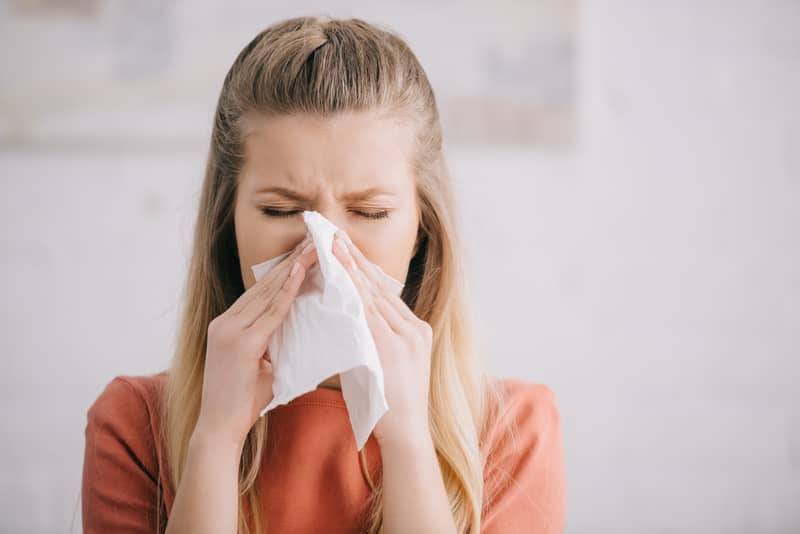Nobody likes to move about with a stuffy or running nose, but sometimes, it can’t be helped. When the lining of the sinuses near the nose gets infected, you feel these symptoms, and it’s clear that you’ve got sinusitis or sinus inflammation. Your best bet to treating this and getting whole again is through acupressure for sinus inflammation.
Having sinuses isn’t the beginning of your woes. On the contrary, sinuses are blessings to us. They are little mechanisms in your head that help drains the passageways of your nose to keep it clean and protect it from bacteria. Four pairs of sinus cavities in your head help perform this cleansing function. They include the maxillary sinuses located below your eyes, the ethmoidal sinuses found between your eyes; the frontal sinuses found above your eyes; and the sphenoidal sinuses located behind the eyes.
It becomes a problem when instead of air, which is what the sinuses are always filled it, it gets filled with fluid that congests it. Mostly, people get sinus infections from colds which inflames the nasal passages. Other ways of getting sinusitis include injury in the nose, tooth infections, getting foreign objects stuck in the nose, and even inhaling smoke.
You know you have sinus inflammation when you have a runny nose or cold that refuses to go after 7 to 10 days accompanied by headaches, facial pain, cough, sore throat, and in some cases, bad breath. When this becomes your story, you can either seek medical attention or alternative remedies like acupressure for sinus inflammation that is easy, costless, safe, and highly effective.
Pressure Points to Relieve Sinus Inflammations
Below is a list of pressure points for sinus inflammation that you can easily locate and massage by yourself for quick and safe relief of sinusitis symptoms.
Acupoint: LI-20 (Other Names: Large Intestine-20/Ying Xiang/Welcome Fragrance)
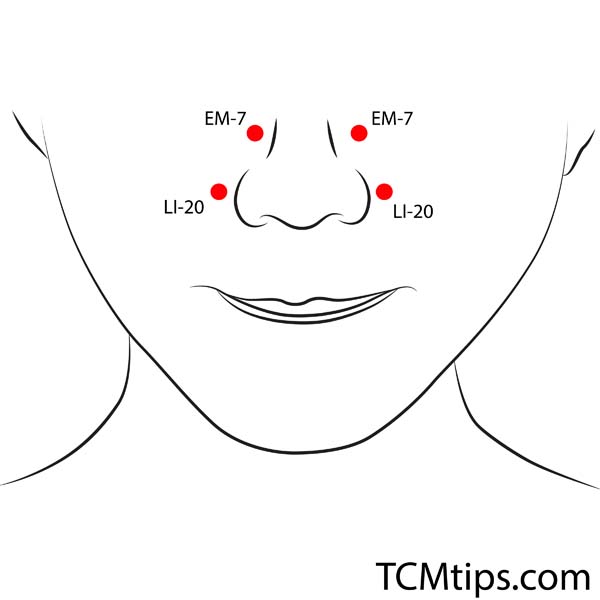
LI-20 is one of the most popular pressure points to relieve sinus inflammation. You can’t talk about acupressure for sinus inflammation without it. Called Yingxiang in Traditional Chinese medicine, this Large Intestine Meridian acupoint is located on the face, on both sides of the base of your nose, where the nose meets the cheeks.
In TCM, this acupoint functions as a dispelled of wind, a clearer of heat, and an opener of the nasal passages. This is why it is used clinically to treat sinus issues and other issues like nasal congestion, epistaxis, and wry face. It is also one of the acupressure points for skin tightening.
To activate this pressure point and reduce the swelling of the mucous membrane in your nose, locate LI-20 and apply gentle pressure on it till it warms up.
Acupoint: EM-7 (Other Names: Bi Tong)
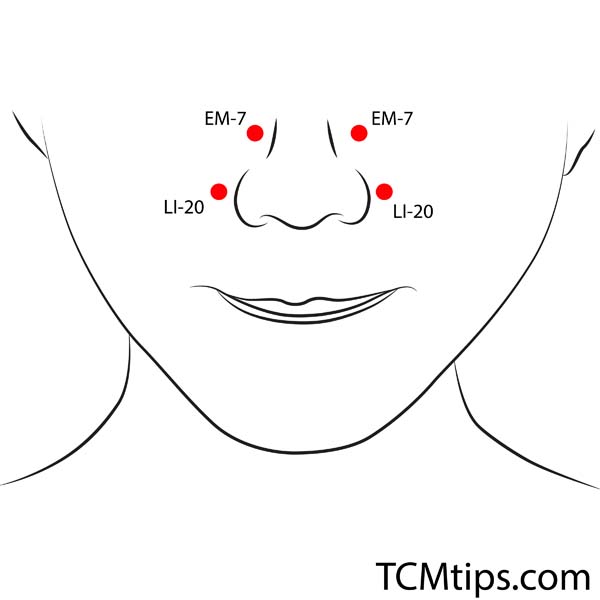
EM-7 or Bitong, as it is called in Chinese, is the acupressure for sinus inflammation that you should massage once you have sinusitis. This acupoint is located slightly above LI-20 at the base of the nose but at the top of the nasolabial groove on both sides of the nose.
To activate Bitong for sinus cavity issues, apply gentle pressure on the acupoint with your two index fingers. The longer you press this acupressure for sinus infection, the better the benefit you get. Clinically, in addition to clearing sinus congestion, Bitong is also used to bring relief to soreness in the nasal region and rhinorrhea.
Acupoint: EM-2 (Other Names: Yin Tang/Hall of Impression)
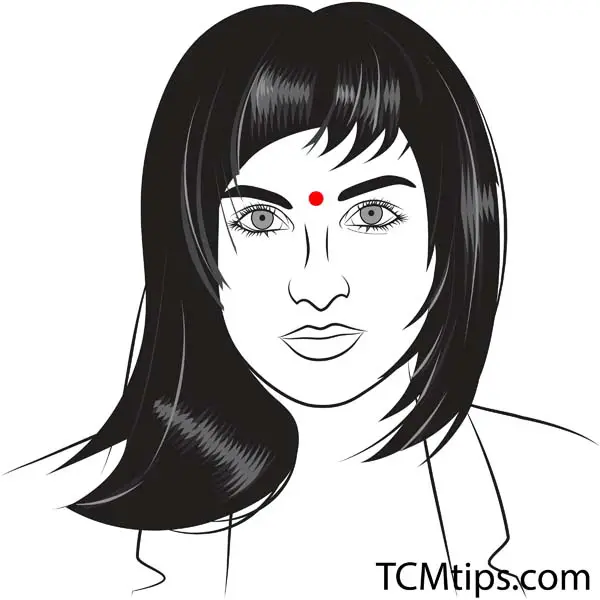
The next acupressure for sinus inflammation worth discussing is EM-2 or Yintang, as it is called in Chinese. Like the other pressure points already discussed, EM-2 is also located on the face. You’ll find it between your eyebrows, at the point where your nose joins with your forehead.
In TCM, Yintang is used to treat other health issues like headaches, insomnia, infantile convulsion, and vertigo. Its position between the eyebrows makes it suitable for treating these problems and serves as one of the acupressure points for the eyes.
To clear the stuffy nose and other nasal-related issues with Yintang, apply firm pressure on this acupoint with your index or middle finger. After a while, adjust the pressure to the point where it begins to feel good.
Acupoint: ST-3 (Other Names: Stomach-3/Ju Liao/Large Bone Hole)
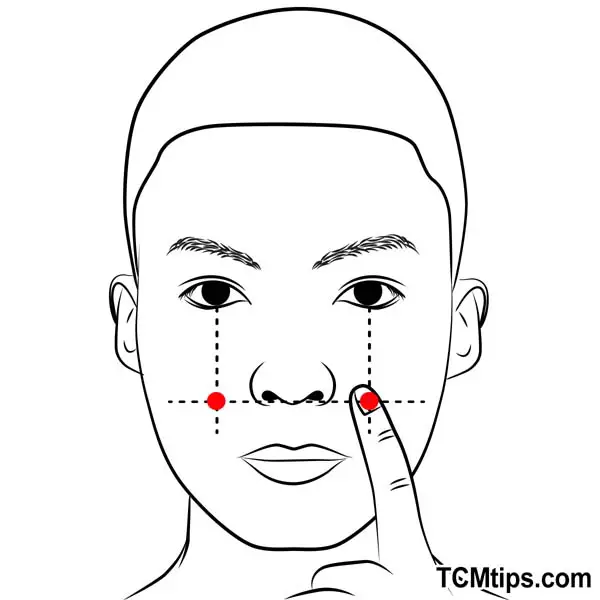
ST-3 is yet another acupoint worth mentioning when it comes to acupuncture for non-allergic rhinitis. In Chinese, this stomach meridian acupoint is called Juliao, which means Great Crevice. It is located on the face as well. It is a point on the cheeks that is in line with the pupil of your eyes and beside the base of the nose where the nose meets the cheeks.
Juliao is effective in treating toothache, facial paralysis, twitching of the eyelids, and swellings of the lips and cheeks, in addition to sinusitis. It is also effective for treating a number of health conditions when used with Small Intestine 18.
All you need to do to enjoy the healing powers of ST-3 is to apply gentle pressure on this acupoint. It is best when you push the cheekbones from below while pushing this acupoint. Also, avoid pushing with too much force to avoid damaging your skin.
Acupoint: GB-20 (Other Names: Gallbladder-20/Feng Chi/Wind Pool)
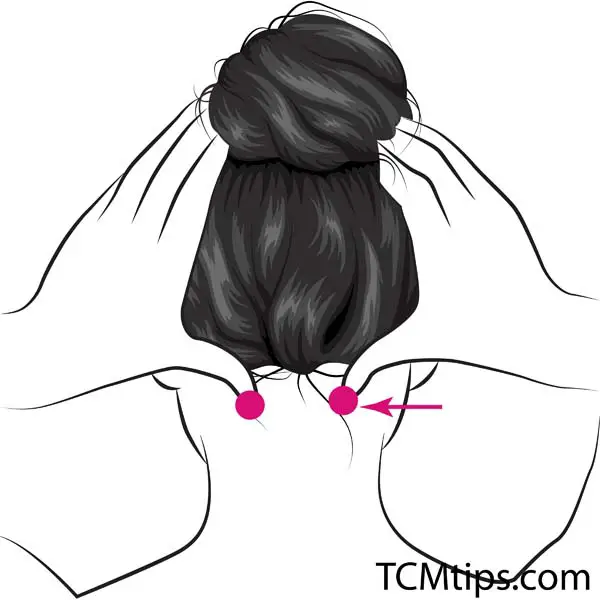
GB-20 or Fengchi, as it is called in Chinese, is a very popular acupoint. It not only serves as acupressure for sinus inflammation but also as one of the acupuncture points for relaxation. You’ll find this acupoint at the nape of the neck, at the grooves behind your ears at the base of your skull.
In TCM, it is taught that GB-20 is the best pressure point to treat any kind of Wind-Cold or Wind-Heat related issues. It is for this reason that Fengchi is also effective in the treatment of common cold, headaches, dizziness, and rhinorrhea.
All you need do to activate the healing power of this acupoint is to locate the acupoint with both thumbs of your hands and apply firm pressure.
Acupoint: GV-16 (Other Names: The Governing Vessel-16/Feng Fu/Wind Palace)
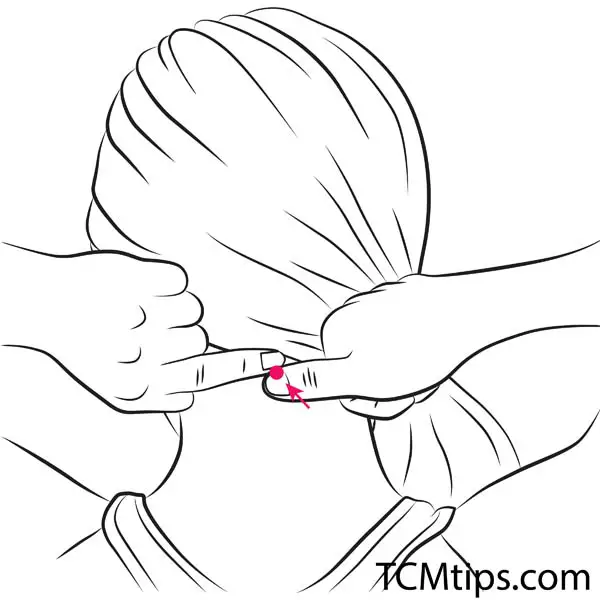
GV-16 is the next pressure point to relieve sinus inflammation that you should know. It is called Feng Fu in Chinese, which is interpreted as Wind Place. You’ll find the GV-16 acupuncture point very close to GB-20. It is on the same line as GB-20 but instead located in the midline of the base of the skull, in the hollow below your skull.
In addition to clearing sinus congestion, Feng Fu is the acupoint for headaches, a stiff neck, blurry vision, hypertension, and anxiety or sadness. All you have to do to enjoy the healing benefits of this acupoint is to locate it and hold it for up to three minutes.
Acupoint: GV-14 (Other Names: The Governing Vessel-14/Da Zhui/Great Vertebra)
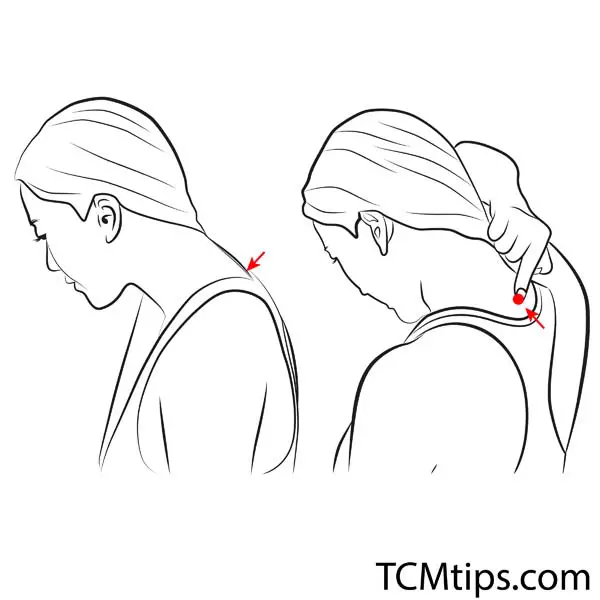
Another Governing Vessel acupoint that serves as acupuncture for allergic rhinitis and sinusitis and is as well worthy of note is GV-14. Unlike GV-16 and the other acupoints discussed so far that are located on the head, this popular pressure point for tonsils is located at the back. It is the point below the most prominent cervical vertebrae, the seventh cervical vertebrae, or the great vertebrae.
TCM practitioners use Dazhui or GV-14 to treat febrile diseases, common cold, rigidity in the neck, and malaria, in addition to sinus inflammation. The reason for this is that Dazhui clears heat, dispels wind, and releases the exterior of the body.
Acupoint: Bl-13 (Other Names: Urinary Bladder-13/Fei Shu/Lung Transporter)
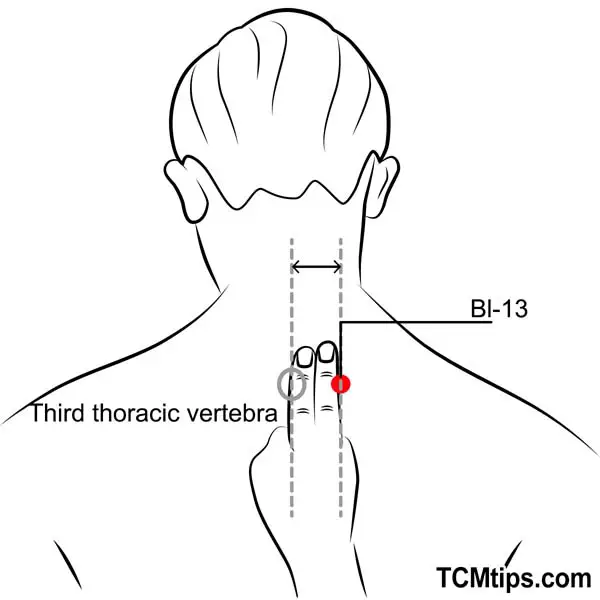
Finally, the last acupuncture for sinus inflammation that you can push at ease for relief of the stuffy nose is Bl-13 or Feishu as it is called in Chinese. Like GV-14, Feishu is located on the spinous process. In its case, it is the point below the third thoracic vertebrae.
Clinically, acupuncture therapists use this acupoint to treat cough, fever, smallpox, and nasal congestion. BL-13 is also one of the acupressure points to push for face pimples. All you have to do to enjoy the healing benefits of this acupoint is to locate it and push it twice a day – morning and evening – for one minute each time.
Can Allergies Cause Sinus Inflammation?
Yes, allergies can cause sinus inflammation. When you inhale irritants like pollen, dust mites, or pet dander, you risk getting sinus inflammation, especially if you’re allergic. The way it works is that when you inhale these irritants as an allergic person, your body will produce chemicals known as histamines that will, in most cases, make your inside nasal layer swell and produce mucus.
However, not all allergies cause sinus inflammation, and neither are reactions from allergies that share the same symptoms as sinus inflammation sinusitis. You may feel the pressure of the swelling of your nasal passages and even have a runny nose, but it would be a normal nasal allergy reaction. The good news is that whatever the case may be, the acupuncture for allergic rhinitis discussed in this article will always sort you out.
How Long Can Sinus Inflammation Last?
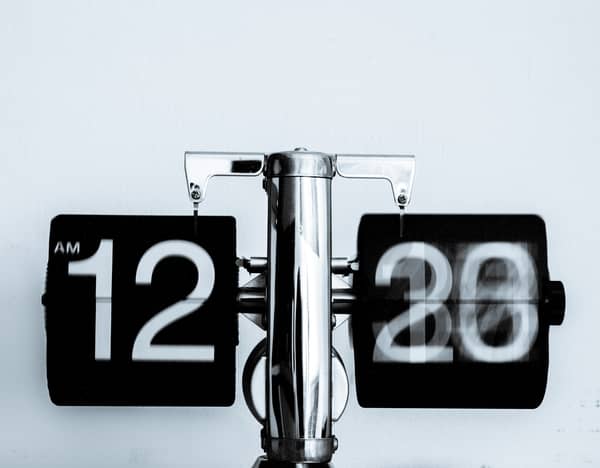
How long it takes sinus inflammation to go depends on the type of sinus infection you have. Sinus inflammation could either be acute, subacute, chronic, or recurrent. Acute sinusitis stays for less than four weeks before the symptoms disappear. For subacute sinusitis, you can experience the symptoms for up to eight weeks as the treatment stays unresponsive at first before you begin to experience changes.
The chronic sinus infection takes more than eight weeks for the symptoms to completely clear up and the reason for this is usually due to poor treatment of repeated acute sinus infections. This is why you need to know the right pressure points to relieve sinus inflammation. Acupuncture for sinus inflammation hardly fails. Finally, recurrent sinus infection hardly clears up completely. You keep experiencing the symptoms of acute sinusitis up to three times a year.
Does Steam Help Sinus Inflammation?
Steam inhalation is one of the home remedies for sinus inflammation that you can use to reduce your symptoms. This kind of therapy involves inhaling water vapor. This works by loosening the mucus in the nasal passages, throat, and lungs, thus relieving symptoms like inflammation and swellings in your nasal passage.
Not only does steam inhalation therapy ease the feeling of irritation and swollen blood vessels along the nasal passageway but also thins out the mucus in your sinuses to enable them to flow out easily. One thing you should have at the back of your mind when inhaling moist, warm steam is that it won’t cure infections like cold or flu, even though it is widely used for cold, flu, sinus infection, bronchitis, and other nasal allergies.

Try our Anti-Aging Gua Sha Tool designed to bring out your skin’s natural glow.
Best Gua Sha Product- Anti-Aging: The tool is designed to target 11 specific aging signs such as wrinkles and sagging skin. By following the 7-step routine, users can improve skin firmness and reduce fine lines naturally.
- Enhances Skincare Routine: It works effectively with serums and lotions, boosting absorption and efficacy of skincare products.
- Visible Skin Improvement: Users can expect a smoother complexion, reduced puffiness, and a more youthful appearance.
 P. Sze
P. Sze 